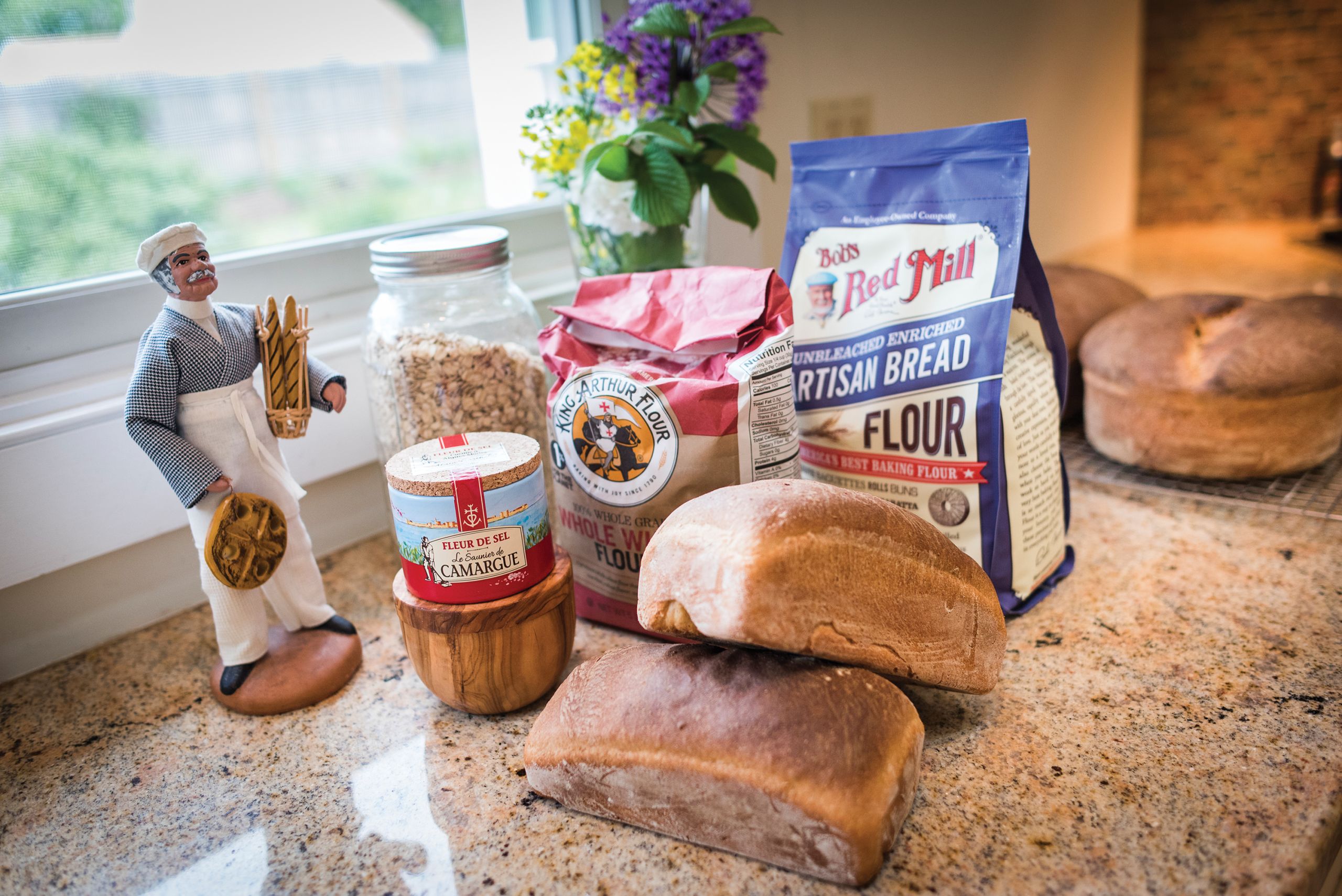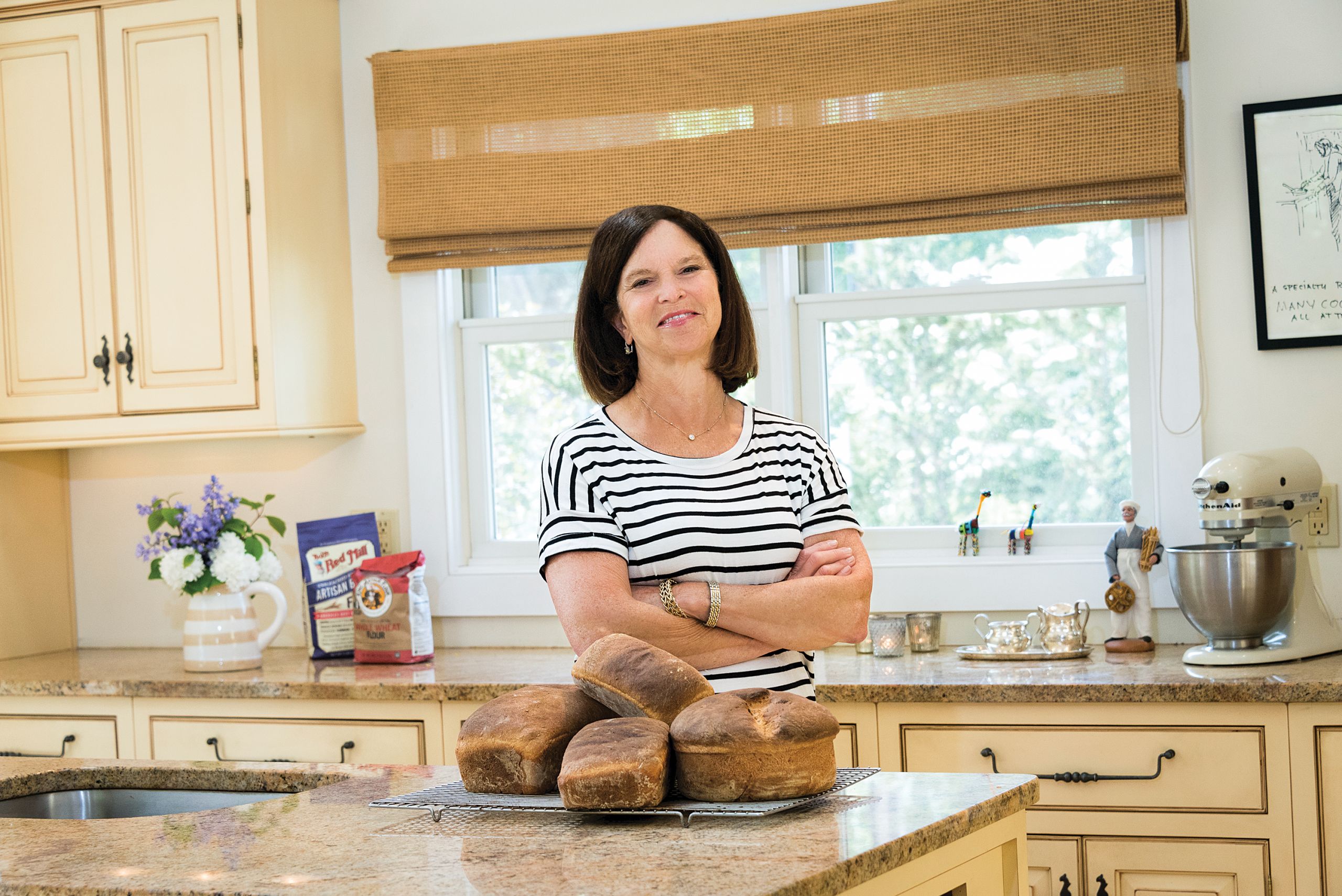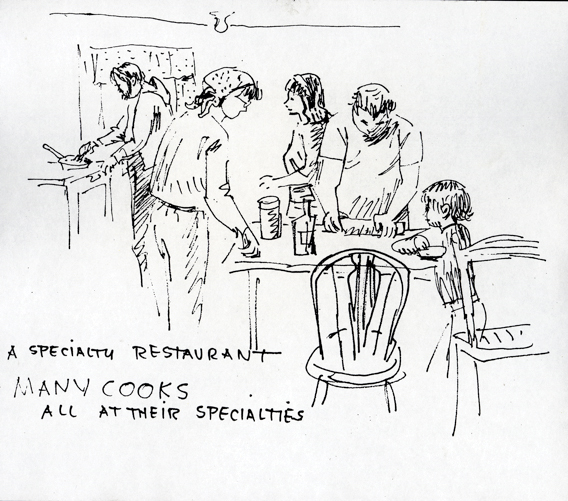Comfort in Food
Posted on July 7, 2017
Elinor Allcott Griffith ’71 said her father, art professor John Allcott Jr., gave away more than 1,000 loaves of what became known around Chapel Hill as “John’s Friendship Bread.” (Photo by Amy Etra)
Author recalls her family’s kitchen aromas as therapy
When she lost her job as a magazine editor after 31 years in the profession, Elinor Allcott Griffith ’71 went home and did just what her father had taught her to do when the going gets rough: She baked bread.
It was not so much that she longed for the taste of the molasses-and-brown-sugar-sweetened, oat-studded loaf, but for the flour-dusted ritual of creating it in her hands. As she writes in her recent cookbook-memoir, comfort came from hearing her father’s voice in her ear, measuring the sugar, punching down the dough and eventually breathing in the aroma of freshly baked bread, just as she had done throughout her childhood.
Griffith’s father, John Allcott Jr., made his living not as a baker but as an art professor. He chaired UNC’s art department in the 1940s and ’50s, championing the arts at the University and throughout the state for decades. Her mother, June Allcott, also an artist, helped create a pioneering UNC course for women returning to the workforce after being homemakers.

Griffith says she felt like the center of attention when helping her father bake. (Photo by Amy Etra)
The Allcotts raised four children in Chapel Hill, teaching them the art of bold, joyful living, in part through a robust love of cooking and eating together.
In her book, The Virtues of Cooking: Recipes to Uplift Family Through Food, Griffith chronicles her life and the recipes that have sustained and enriched it, beginning with her father’s bread. She often would find him making the loaves in the family’s galley kitchen. “One of the seminal things that drove me to share this was this memory of bread baking with my dad,” she said.
The Allcotts made friends by sharing food, with the art professor giving away more than 1,000 loaves of what became known around Chapel Hill as “John’s Friendship Bread.”
The ritual of bread-making was about sharing time with his family as well.
“Dad could have been incredibly preoccupied at that point, about whatever was going on in the world, but it didn’t feel like that to me,” she says. “As a kid to be there and to be helping out, I felt like I was the center of attention. That, to me, is still the most powerful part. I think parents don’t realize something even as small as pulling kids in to make the frosting, to make it feel like the kid is the focus and in on the fun. … I think the benefits go well beyond food. It helps slow time down.”
Griffith followed her parents’ lead and built bonds with her own children at the stove and around the table. When it came time for Griffith to seek a new path after her career as a senior editor at Reader’s Digest ended, it was her daughter Kathleen ’04 who gave her the “kick in the pants” she needed.
She suggested her mother dedicate her energies to her love of travel and food by leading cooking-school trips to France. Though reluctant at first, Griffith in 2007 took her first group to study in the Provence kitchen where Julia Child cooked and wrote the second volume of Mastering the Art of French Cooking.
“It was just such fun to take people there and cook in Julia’s kitchen — the same peg boards, the same outlines of utensils on the wall,” she said.

One of her father’s drawings of a busy kitchen, used in her cookbook.
Not only did Griffith find herself reinvigorated, she saw others become ignited by Child’s own sense of fearlessness in life and the kitchen. She since has led cooking-school tours to Paris and Italy’s Amalfi Coast and has plans to take a group to Morocco.
The collection of recipes, stories and her father’s sketches that comprise The Virtues of Cooking would no doubt make her parents proud. But Griffith thinks they would be puzzled that their approach to food and family might be regarded as novel in today’s iPhone-fueled, fast-casual world.
“I think it came very naturally to them,” she said. “I think they would be sort of surprised that there was anything unusual about it. Today when you think about raising kids and values … honestly, in some ways, they wouldn’t make a big deal about it.”
— Amber Nimocks ’94
Friendship Bread
Yield: 4 loaves
This recipe is like lyrics for the old Jackson 5 song that goes, “All you gotta do is repeat after me! A, B, C! It’s easy as one, two, three. As simple as do, re, mi. A, B, C. One, two, three.” So then, it’s actually easy to follow the ABCs and 123s of making Friendship Bread.
2 packets yeast
1 teaspoon sugar
¼ cup warm water
4 cups warm water
4 cups bread flour
1½ cups oatmeal (make ahead and cool)
5 tablespoons melted butter
1 cup brown sugar
5 tablespoons molasses
Pinch of baking soda
1 tablespoon salt
7 to 8 cups bread flour
• A. Combine the yeast, sugar and warm water in the large mixing bowl of a heavy-duty mixer, stir and let sit for 5 minutes.
• B. Add 4 cups warm water and 4 cups bread flour to make a sponge. Let double in size.
• C. Now, using the bread hook, stir in the remaining ingredients, including more flour — a cup or two at a time. Once ingredients are mixed and the consistency isn’t too sticky (keep adding more flour as needed), put dough on a floured surface and knead for 10 minutes. Place in a clean, lightly greased bowl, cover with a kitchen towel and let double in size. Punch down. Divide the dough into four 9-by-5-inch loaf pans (prepare pans by wiping a trace of butter along the bottom and sides, then dusting with flour) and let the dough rise for about an hour.
• The 123s of baking Friendship Bread: Preheat oven to 450 F. Bake the bread for 15 minutes. Then turn down the oven to 425 F for another 15 minutes. Done! The top should be golden brown and crusty hard. Just to be sure, though, thump gently on the top to check for a hollow sound. Cool on a rack.
Helpful Hint: Instead of making 4 loaves, try making 3 regular loaves and two smaller ones to give away. That’s Flour Power! Friendship Bread is meant to be shared!
Thanks for reading the Carolina Alumni Review
Carolina Alumni members, sign in to continue reading.
Not yet a member? Become one today.
